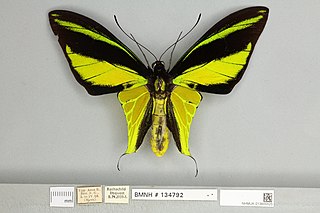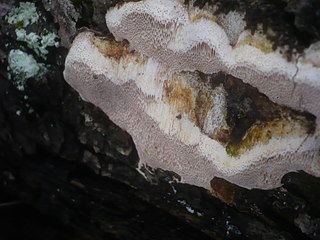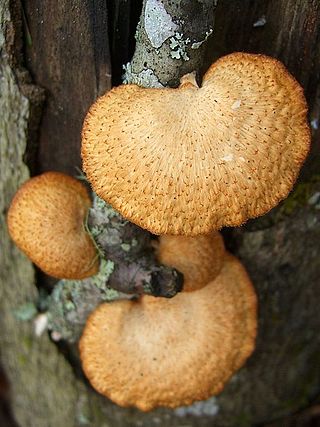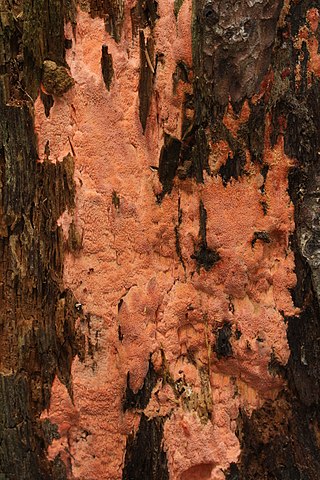
Cerioporus squamosus aka Polyporus squamosus is a basidiomycete bracket fungus, with common names including dryad's saddle and pheasant's back mushroom. It has a widespread distribution, being found in North America, Australia, Asia, and Europe, where it causes a white rot in the heartwood of living and dead hardwood trees. The name "dryad's saddle" refers to creatures in Greek mythology called dryads who could conceivably sit and rest on this mushroom, whereas the pheasant's back analogy derives from the pattern of colors on the bracket matching that of a pheasant's back.

The genus Sciurus contains most of the common, bushy-tailed squirrels in North America, Europe, temperate Asia, Central America and South America.

Polyporus is a genus of poroid fungi in the family Polyporaceae.

The Polyporaceae are a family of poroid fungi belonging to the Basidiomycota. The flesh of their fruit bodies varies from soft to very tough. Most members of this family have their hymenium in vertical pores on the underside of the caps, but some of them have gills or gill-like structures. Many species are brackets, but others have a definite stipe – for example, Polyporus badius.

Mammuthus meridionalis, or the southern mammoth, is an extinct species of mammoth native to Eurasia during the Early Pleistocene, living from around 2.5 million years ago to 800,000 years ago.

Ornithoptera meridionalis, the southern tailed birdwing, is the smallest species of the genus Ornithoptera. It is known from a handful of localities in southeast Papua, New Guinea and several localities along the south coast of Irian Jaya.

Perenniporia is a cosmopolitan genus of bracket-forming or crust-like polypores in the family Polyporaceae. They are dimitic or trimitic with smooth, thick-walled basidiospores and cause a white rot in affected wood.

The Chatham kākā or Chatham Island kākā is an extinct parrot species previously found on the Chatham Islands, New Zealand. The first individuals were thought to belong to the New Zealand kākā, but detailed examination of the subfossil bones showed that they actually belong to a separate endemic species. The species became extinct within the first 150 years of the arrival of the Polynesians around 1500, long before any European settlers. No skins or descriptions are available.

Lentinus is a genus of fungi in the family Polyporaceae. The genus is widely distributed, with many species found in subtropical regions.

Neofavolus alveolaris, commonly known as the hexagonal-pored polypore, is a species of fungus in the family Polyporaceae. It causes a white rot of dead hardwoods. Found on sticks and decaying logs, its distinguishing features are its yellowish to orange scaly cap, and the hexagonal or diamond-shaped pores. It is widely distributed in North America, and also found in Asia, Australia, and Europe.
Polyporus phyllostachydis is a fungus species belonging to the genus Polyporus. It is a species known from Japan to grow on the ground on the living or dead roots of the Phyllostachys edulis bamboo.
Bathycongrus is a genus of eels in the family Congridae.

Picipes badius, commonly known as the black-footed polypore or black-leg, is a species of fungus in the family Polyporaceae. It causes a white rot of hardwoods and conifers. The species is found in temperate areas of Asia, Australia, Europe, and North America. It has a dark brown or reddish-brown cap that reaches a diameter of 25 cm (9.8 in), and a stipe that is often completely black or brown at the top and black at the base.
Bathycongrus polyporus is an eel in the family Congridae. It was described by David G. Smith and Robert H. Kanazawa in 1977, originally under the genus Rhechias. It is a marine, deep water-dwelling eel which is known from the Straits of Florida and the northern coast of Cuba, in the western central Atlantic Ocean. It dwells at a depth range of 439–549 meters. Males can reach a maximum total length of 43 centimeters.

Cerioporus is a genus of fungi in the family Polyporaceae. The type species is Cerioporus squamosus. Many species in Cerioporus were formerly placed in the genus Polyporus, however phylogenetic analysis shows that Cerioporus is a separate genus. It has been reported that mushrooms have significant antioxidant and antimicrobial activity.

Lentinus arcularius, also known as the spring polypore, is a species of fungus in the family Polyporus. It is or the scientific name Lentinus arcularius. It has been found on all continents, but has primarily been documented in the United States, Austria, Mexico, Australia, and Japan. It was first documented in 1783 by German naturalist August Batsch under the name Boletus arcularius. It was later renamed to Polyporus arcularius in 1821 by Swedish mycologist Elias Magnus Fries before being recently (2010) transferred to the genus Lentinus.

Polyporus gayanus is a species of fungus in the genus Polyporus. It was first documented in 1846 by French mycologist Joseph-Henri Léveillé.

Polyporus tuberaster is a species of fungus in the genus Polyporus.

Rhodonia is a fungal genus in the family Fomitopsidaceae. It is a monotypic genus, containing the single crust fungus Rhodonia placenta. A brown rot species, R. placenta is found in China, Europe, and North America, where it grows on decaying conifer wood.














